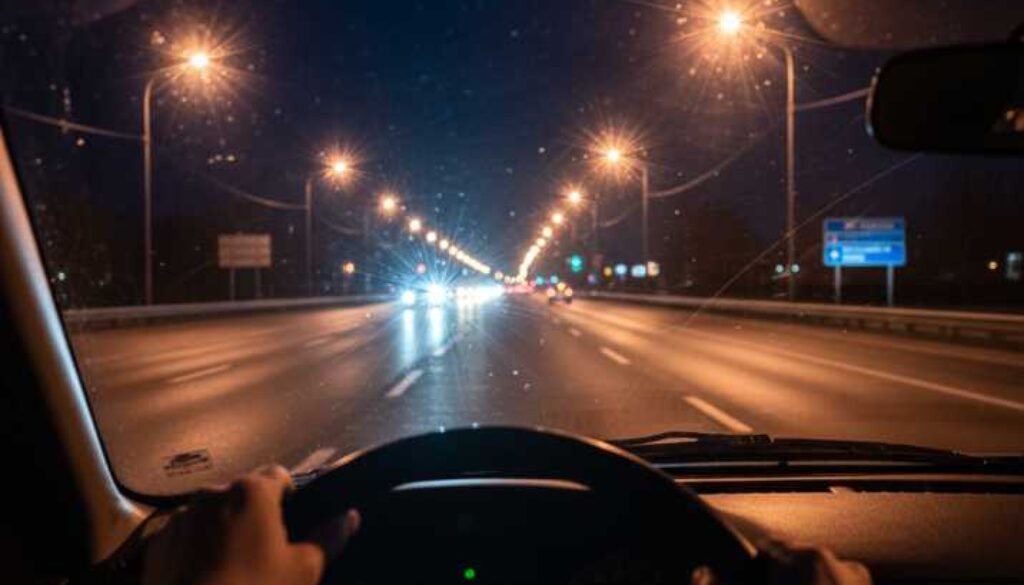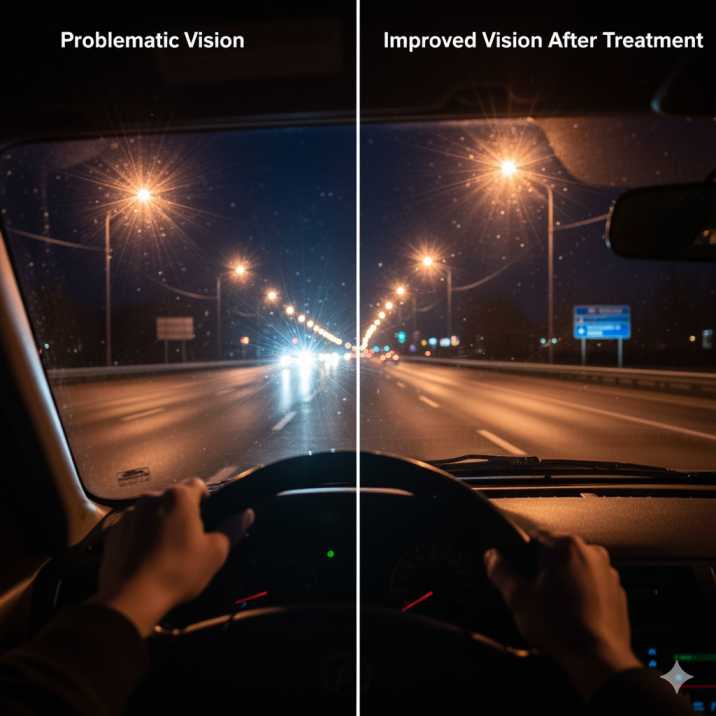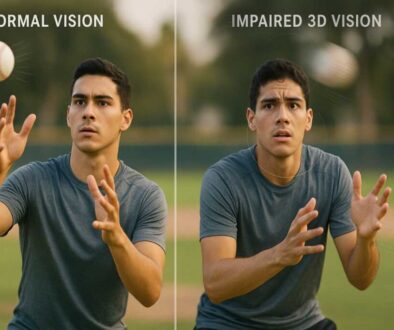Night Driving Vision Problems: Causes & Expert Treatment

The Hidden Connection Between Vision Problems and Night Driving Struggles
Are you among the millions of drivers who feel anxious when the sun sets? Do oncoming headlights seem blindingly bright, making it difficult to see road signs, lane markings, or pedestrians? You’re not alone. Recent studies show that night driving difficulties affect over 50% of drivers, yet many people don’t realize these challenges could indicate underlying vision problems that extend far beyond simple night blindness.
While it’s natural for human vision to be less effective in low-light conditions, persistent struggles with night driving often point to specific visual dysfunctions that can be successfully treated. Understanding the difference between normal age-related changes and treatable vision problems could be the key to regaining your confidence behind the wheel—and improving your overall quality of life.
Understanding Normal vs. Problematic Night Vision
How Human Vision Works at Night
Human eyes are fundamentally designed for daylight vision. When darkness falls, several physiological changes occur that naturally reduce our visual capabilities:
- Pupil dilation: Your pupils expand to let in more light, but this also allows light to enter from all directions, potentially causing visual confusion
- Rod cell dependency: Night vision relies primarily on rod cells in your retina, which detect light and dark but provide mostly black-and-white vision
- Reduced contrast sensitivity: The ability to distinguish between similar shades decreases significantly in low light.
- Slower adaptation: It takes 20-30 minutes for your eyes to fully adapt to darkness
When Night Driving Becomes a Vision Problem
While some difficulty seeing at night is normal, certain symptoms indicate potential vision problems that require professional evaluation:
Red Flag Symptoms
- Severe glare sensitivity: Oncoming headlights cause painful, disabling glare that takes time to recover from
- Halos and starbursts around lights: Lights appear to have rainbow-colored rings or star-like projections
- Double vision or ghosting: Seeing multiple images of the same object, especially lights
- Poor depth perception: Difficulty judging distances between vehicles or determining how far away objects are
- Frequent headaches or eye strain: Physical discomfort during or after night driving
- Panic or anxiety while driving at night: Emotional stress related to visual uncertainty
Common Vision Problems That Sabotage Night Driving
Binocular Vision Dysfunction (BVD)
Binocular Vision Dysfunction occurs when your eyes struggle to work together as a coordinated team. This condition affects an estimated 56% of American adults, yet it often goes undiagnosed because symptoms can be subtle during the day but become pronounced at night.
In low-light conditions, your visual system works harder to maintain proper eye alignment and focus. When you have BVD, this extra effort can lead to:
- Double vision or shadowed images of headlights and street signs
- Difficulty maintaining focus on the road ahead
- Eye strain and fatigue that worsen throughout the drive
- Reduced 3D vision affecting distance judgment
Convergence Insufficiency
Convergence insufficiency is the inability to keep your eyes properly aligned when focusing on nearby objects. While this might seem irrelevant to distance driving, it significantly impacts your ability to:
- Read dashboard instruments clearly
- Switch focus between the dashboard and the road
- Maintain comfortable vision during longer drives
Strabismus and Eye Misalignment
Strabismus, commonly known as crossed eyes or wandering eyes, can be constant or intermittent. Intermittent strabismus often becomes more noticeable during stressful visual situations like night driving. This condition can cause:
- Inconsistent depth perception
- Double vision that comes and goes
- Increased visual fatigue and headaches
- Difficulty maintaining straight-ahead gaze
Amblyopia (Lazy Eye)
Amblyopia, or lazy eye, affects up to 1 in 20 people and can significantly impact night driving safety. When one eye has reduced visual input, your brain relies more heavily on the stronger eye, leading to:
- Compromised peripheral vision
- Reduced depth perception and 3D vision
- Increased difficulty detecting obstacles in low light
- Greater susceptibility to glare and light sensitivity
Refractive Errors: Beyond Simple Prescription Updates
Even if you have updated glasses or contact lenses, certain refractive errors can become more problematic at night:
Astigmatism and Light Distortion
Astigmatism causes the cornea or lens to have an irregular shape, leading to uneven light focus. At night, this creates characteristic problems:
- Streaky, elongated appearance of lights
- Halos around headlights and street lamps
- Difficulty distinguishing between similar-colored objects
- Increased squinting and eye strain
The Science Behind Night Vision Problems: Recent Research Findings
Study 1: Visual Function and Night Driving Difficulties
A comprehensive 2023 study published in the Journal of Optometry examined 107 drivers to investigate the relationship between visual function and self-reported night driving difficulties. The research found that:
- Contrast sensitivity was the strongest predictor of night driving problems, even more than standard visual acuity
- Disability glare significantly correlated with reported driving difficulties
- Mesopic vision (twilight vision) was more predictive of problems than photopic (daylight) vision
Study 2: Age-Related Changes in Night Driving Performance
Research published in Human Factors: The Journal of the Human Factors and Ergonomics Society revealed that age-related vision changes affect night driving performance more dramatically than previously understood:
- Recognition of pedestrians decreased by 75% in older drivers compared to younger ones
- Retroreflective markings on pedestrian limbs improved detection rates by 300% for all age groups
- Reaction times increased significantly as illumination decreased
Study 3: Night Vision Enhancement Systems and Driver Performance
A National Highway Traffic Safety Administration study on night vision enhancement systems found that:
- Tactile and auditory warnings were more effective than visual warnings for older drivers
- Multi-modal warnings involving visual cues actually degraded performance
- Technology alone cannot compensate for underlying vision problems
Effective Treatment Solutions for Night Driving Vision Problems
Vision Therapy: Retraining Your Visual System
Vision therapy is a scientifically backed treatment approach that trains your eyes and brain to work together more effectively. Unlike glasses or surgery, vision therapy addresses the root causes of visual dysfunction through:
- Customized eye exercises that strengthen eye muscle coordination
- Binocular vision training to improve eye teaming skills
- 3D vision enhancement for better depth perception
- Visual processing improvement for faster, more accurate visual information processing
Success Story: “After vision therapy at Cook Vision Therapy Center, I can finally drive at night without panic attacks. The road signs are clear, and I can judge distances properly again.” – Sarah M., Atlanta
Specialized Prism Lenses
For patients with eye misalignment or binocular vision dysfunction, prism lenses can provide immediate relief by:
- Redirecting light to help eyes work together
- Reducing eye strain and fatigue
- Eliminating double vision
- Improving depth perception and 3D vision
Anti-Reflective Coatings and Specialized Lenses
Advanced lens technologies can significantly improve night driving comfort:
- Anti-reflective (AR) coatings reduce internal reflections and increase light transmission
- Blue light filtering helps reduce glare from LED headlights
- Photochromic lenses adapt to changing light conditions
Immediate Steps to Improve Your Night Driving Safety
Vehicle and Environmental Modifications
- Clean your windshield and headlights regularly – even small amounts of dirt can create significant glare.
- Ensure proper headlight alignment – misaligned headlights reduce your visibility and increase glare for other drivers.
- Adjust your rearview mirror for night driving – use the flip tab to reduce glare from following vehicles.
- Dim your dashboard lights – bright interior lights impair your night vision adaptation.
Driving Techniques and Behaviors
- Use the 20-20-20 rule – every 20 minutes, look at something 20 feet away for 20 seconds
- Avoid looking directly at oncoming headlights – focus on the right edge of the road or lane markings
- Increase following distance – allow extra time for reaction in reduced visibility
- Reduce speed appropriately – slower speeds give you more time to react to hazards
When to Seek Professional Help: Warning Signs You Shouldn’t Ignore
If you experience any of the following symptoms, it’s time to schedule a comprehensive vision evaluation:
| Urgent Warning Signs | What It Could Indicate |
|---|---|
| Severe panic or anxiety while driving at night | Binocular vision dysfunction, convergence insufficiency |
| Double vision or ghosting of lights | Strabismus, eye misalignment, and neurological issues |
| Persistent headaches after driving | Eye strain, focusing problems, and refractive errors |
| Avoiding night driving completely | Multiple underlying vision problems requiring comprehensive evaluation |
How Cook Vision Therapy Center Can Help
At Cook Vision Therapy Center in Marietta, Georgia, we specialize in diagnosing and treating the vision problems that make night driving difficult and dangerous. With over 40 years of experience, Dr. David Cook and Dr. Ekta Patel have helped thousands of patients regain their confidence behind the wheel.
Our Specialized Approach to Night Driving Vision Problems
- Comprehensive Vision Evaluation: We assess seven crucial visual abilities beyond 20/20 eyesight
- 3D Vision Assessment: Specialized testing for depth perception and binocular vision
- Customized Vision Therapy: Personalized treatment programs addressing your specific challenges
- Prism Lens Therapy: Advanced optical solutions for eye alignment issues
- Post-Concussion Rehabilitation: Specialized care for vision problems following head injuries
Why Choose Vision Therapy Over Other Options?
Unlike traditional eye care that focuses on glasses and surgery, vision therapy addresses the root causes of visual dysfunction. Our patients typically experience:
- Elimination of night driving anxiety and panic attacks
- Improved depth perception and 3D vision
- Reduced eye strain and fatigue
- Better reading comprehension and academic performance
- Enhanced sports performance and coordination
Ready to regain your night driving confidence? Call Cook Vision Therapy Center at (770) 419-0400 for your free consultation.
References and Resources
Key Scientific Studies and Citations
1. Visual Function and Night Driving Difficulties Research Journal of Optometry, 2023 Citation: Boadi-Kusi, S.B., Aikins, P.M., Zaabaar, E. (2023). Visual function correlates of self-reported vision-related nighttime driving difficulties. Journal of Optometry, 17(3), 100506.
Link: https://pmc.ncbi.nlm.nih.gov/articles/PMC10777108/
Key Finding: This comprehensive study of 107 drivers found that contrast sensitivity was the strongest predictor of night driving problems, even more than standard visual acuity. The research demonstrated that mesopic vision (twilight vision) was more predictive of driving difficulties than photopic (daylight) vision.
2. Binocular Vision Dysfunction Prevalence Statistics Annals of Ophthalmology, 2001 & Optometrists.org, 2021 Citation: Statistics published in the Annals of Ophthalmology (Sept. 2001), as referenced in “Binocular Vision Disorders: 6 Frequent Q&As” – Optometrists.org
Link: https://www.optometrists.org/vision-therapy/guide-to-vision-therapy/binocular-vision-disorders-6-frequent-qas/
Key Finding: 60 million American adults experience symptoms of a binocular vision disorder, representing over 56% of the adult population. This statistic highlights the widespread nature of vision problems that can affect daily activities, including night driving.
3. Age-Related Changes in Night Driving Performance Human Factors: The Journal of the Human Factors and Ergonomics Society, 2007 Citation: Wood, J.M., Lacherez, P., Tyrrell, R.A. (2007). Effects of age and illumination on night driving: a road test. Human Factors, 49(6), 1115-1131.
Link: https://pubmed.ncbi.nlm.nih.gov/18074710/
Key Finding: This controlled road test study revealed that recognition of pedestrians decreased by 75% in older drivers compared to younger ones during night conditions. The research also found that retroreflective markings on pedestrian limbs improved detection rates by 300% for all age groups.
Take Control of Your Night Driving Future
Night driving difficulties are not an inevitable part of aging or something you have to accept. The latest research clearly shows that many night vision problems stem from treatable visual dysfunctions that can be successfully addressed through specialized vision therapy.
If you’re avoiding night driving, experiencing anxiety behind the wheel after dark, or noticing any of the warning signs discussed in this article, don’t wait. The sooner you address underlying vision problems, the better your outcomes will be.
At Cook Vision Therapy Center, we’ve seen countless patients transform their lives through targeted vision therapy. From eliminating night driving panic attacks to restoring confidence in low-light conditions, our specialized approach addresses the root causes of visual dysfunction rather than just masking symptoms.
Take Action Today
- Schedule a comprehensive vision evaluation to identify any underlying vision problems.
- Discuss your night driving concerns with a vision therapy specialist
- Explore treatment options that address your specific visual challenges
- Begin your journey toward safer, more confident night driving
Contact Cook Vision Therapy Center
Address: 1395 S Marietta Pkwy, Building 400, Suite 107, Marietta, GA 30067
Serving Metro Atlanta, including Marietta, Sandy Springs, Roswell, Duluth, and surrounding communities.
FAQs
-
-
Night vision issues often stem from uncorrected eye conditions like astigmatism, cataracts, or glare sensitivity from bright headlights. Updated glasses or eye exams help improve this.
-




